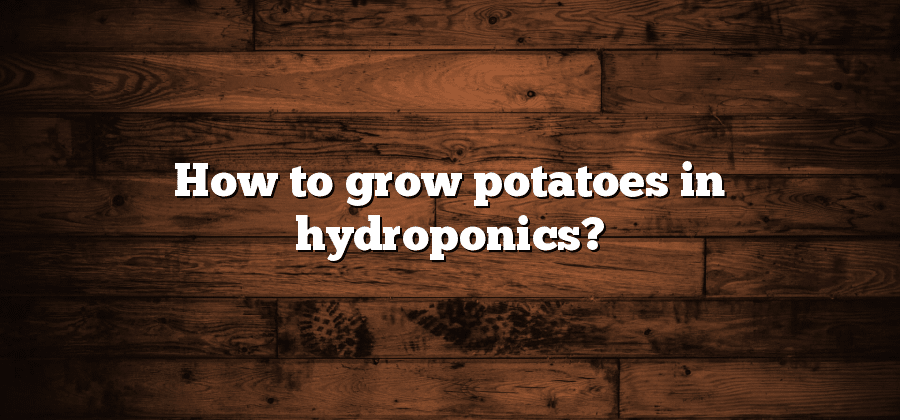Selecting the Right Potato Varieties
When it comes to selecting the right potato varieties for your hydroponic system, there are a few factors to consider. Firstly, ensure that you choose varieties that are suitable for hydroponic cultivation. These varieties are often referred to as “short season” or “compact” potatoes, as they have a shorter growing cycle and take up less space. Some popular choices include Yukon Gold, Red Pontiac, and Kennebec. Additionally, take into account your personal preferences and culinary needs, such as whether you prefer a starchy or waxy potato. Properly selecting the right potato varieties will lay the foundation for a successful hydroponic potato growing experience.
Another important aspect to consider when selecting potato varieties is disease resistance. Different varieties have varying levels of resistance to common potato diseases such as blight, scab, and viruses. It is crucial to choose varieties that have a high resistance to these diseases, as it will significantly reduce the risk of crop loss and the need for chemical interventions. Consulting with a local agricultural extension office or expert in hydroponic potato cultivation can offer valuable insights on disease-resistant varieties that thrive in your region. By prioritizing disease resistance in your selection process, you can minimize the potential for losses and maximize the productivity of your hydroponic potato garden.
Preparing the Hydroponic System
Setting up a hydroponic system for growing potatoes requires careful preparation to ensure optimal plant growth and productivity. The first step is to choose the right system that suits your space and needs. Hydroponic systems come in various types such as deep water culture, nutrient film technique, and aeroponics. Consider factors like available space, budget, and expertise when selecting the system that will work best for you.
Once you have chosen a hydroponic system, it is essential to assemble and install it correctly. Start by following the manufacturer’s instructions or consulting a professional if required. Ensure that all the components, including the reservoir, pumps, grow trays, and aerators, are properly cleaned and sanitized. Also, test the system for any leaks or malfunctions before proceeding with the next steps. Proper preparation of the hydroponic system will provide a solid foundation for successful potato cultivation and ensure a healthy growing environment for your plants.
Providing the Ideal Nutrient Solution
When it comes to growing potatoes in a hydroponic system, providing the ideal nutrient solution is crucial for the success of your crops. Hydroponics is a method of growing plants without soil, and as such, it requires a precise balance of nutrients to ensure optimal growth and development.
The nutrient solution serves as the primary source of essential elements for the plants, including nitrogen, phosphorus, potassium, and various micronutrients. Achieving the ideal nutrient solution involves a thorough understanding of the specific requirements of potatoes at each growth stage. Balancing the nutrient ratios and maintaining the solution’s pH is essential to prevent nutrient deficiencies or toxicities that can hinder plant growth. By carefully monitoring and adjusting the nutrient solution, growers can provide the necessary elements needed for healthy and vigorous potato plants.
Planting Potatoes in Hydroponics
One key factor in the success of growing potatoes in a hydroponic system is selecting the right potato varieties. Certain potato varieties are better suited for growing in a soilless system due to their compact size and disease resistance. It is important to research and choose varieties that have a reputation for performing well in hydroponics, such as Yukon Gold or Red Pontiac.
Once the appropriate potato varieties have been selected, it is essential to prepare the hydroponic system properly. This involves ensuring that the system is clean and free from any potential contaminants. Additionally, the system should be set up in a location that receives adequate sunlight or artificial lighting. It is important to create an environment that mimics the conditions potatoes would experience in traditional soil-based cultivation. This includes providing adequate air circulation and maintaining optimal temperature and humidity levels.
Managing Temperature and Humidity
When growing potatoes in a hydroponic system, managing temperature and humidity levels is crucial for the plants’ success. Controlling these factors ensures that the potatoes grow optimally and minimizes the risk of diseases and pests.
Maintaining an ideal temperature for potato plants can be achieved by keeping the hydroponic environment between 60°F (15°C) and 80°F (26°C). This temperature range allows for optimal growth and development while preventing the plants from becoming stressed. Additionally, it is important to monitor humidity levels in the hydroponic system. Ideally, the humidity should be around 60% to 80% to create a favorable environment for potato plants. Balancing temperature and humidity will contribute to healthier plants and increase the chances of a successful potato harvest in a hydroponic system.






